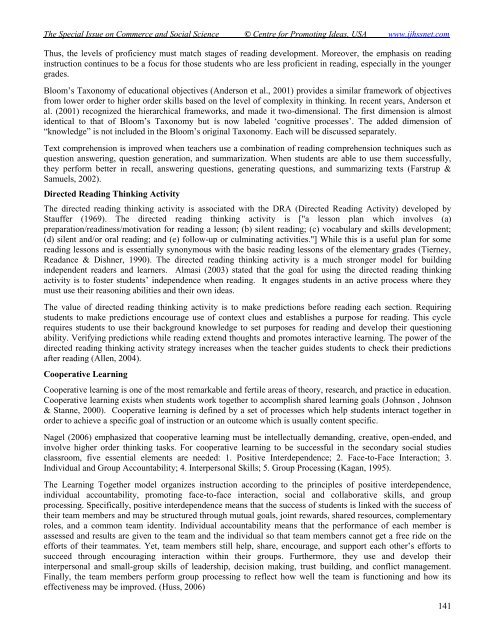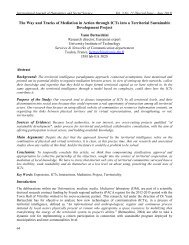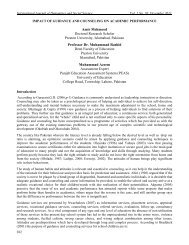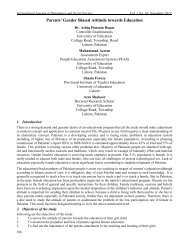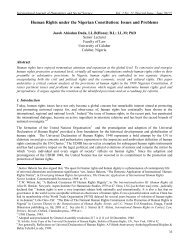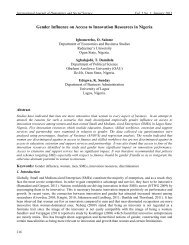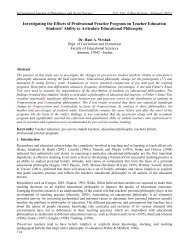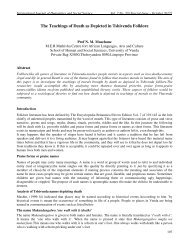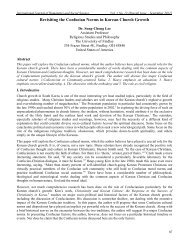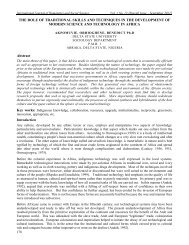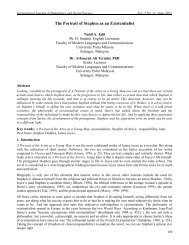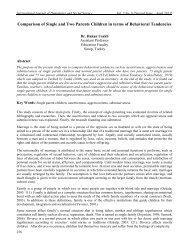The Effect of the Directed Reading Thinking Activity through ...
The Effect of the Directed Reading Thinking Activity through ...
The Effect of the Directed Reading Thinking Activity through ...
You also want an ePaper? Increase the reach of your titles
YUMPU automatically turns print PDFs into web optimized ePapers that Google loves.
<strong>The</strong> Special Issue on Commerce and Social Science © Centre for Promoting Ideas, USA www.ijhssnet.com<br />
Thus, <strong>the</strong> levels <strong>of</strong> pr<strong>of</strong>iciency must match stages <strong>of</strong> reading development. Moreover, <strong>the</strong> emphasis on reading<br />
instruction continues to be a focus for those students who are less pr<strong>of</strong>icient in reading, especially in <strong>the</strong> younger<br />
grades.<br />
Bloom’s Taxonomy <strong>of</strong> educational objectives (Anderson et al., 2001) provides a similar framework <strong>of</strong> objectives<br />
from lower order to higher order skills based on <strong>the</strong> level <strong>of</strong> complexity in thinking. In recent years, Anderson et<br />
al. (2001) recognized <strong>the</strong> hierarchical frameworks, and made it two-dimensional. <strong>The</strong> first dimension is almost<br />
identical to that <strong>of</strong> Bloom’s Taxonomy but is now labeled ‘cognitive processes’. <strong>The</strong> added dimension <strong>of</strong><br />
“knowledge” is not included in <strong>the</strong> Bloom’s original Taxonomy. Each will be discussed separately.<br />
Text comprehension is improved when teachers use a combination <strong>of</strong> reading comprehension techniques such as<br />
question answering, question generation, and summarization. When students are able to use <strong>the</strong>m successfully,<br />
<strong>the</strong>y perform better in recall, answering questions, generating questions, and summarizing texts (Farstrup &<br />
Samuels, 2002).<br />
<strong>Directed</strong> <strong>Reading</strong> <strong>Thinking</strong> <strong>Activity</strong><br />
<strong>The</strong> directed reading thinking activity is associated with <strong>the</strong> DRA (<strong>Directed</strong> <strong>Reading</strong> <strong>Activity</strong>) developed by<br />
Stauffer (1969). <strong>The</strong> directed reading thinking activity is ["a lesson plan which involves (a)<br />
preparation/readiness/motivation for reading a lesson; (b) silent reading; (c) vocabulary and skills development;<br />
(d) silent and/or oral reading; and (e) follow-up or culminating activities."] While this is a useful plan for some<br />
reading lessons and is essentially synonymous with <strong>the</strong> basic reading lessons <strong>of</strong> <strong>the</strong> elementary grades (Tierney,<br />
Readance & Dishner, 1990). <strong>The</strong> directed reading thinking activity is a much stronger model for building<br />
independent readers and learners. Almasi (2003) stated that <strong>the</strong> goal for using <strong>the</strong> directed reading thinking<br />
activity is to foster students’ independence when reading. It engages students in an active process where <strong>the</strong>y<br />
must use <strong>the</strong>ir reasoning abilities and <strong>the</strong>ir own ideas.<br />
<strong>The</strong> value <strong>of</strong> directed reading thinking activity is to make predictions before reading each section. Requiring<br />
students to make predictions encourage use <strong>of</strong> context clues and establishes a purpose for reading. This cycle<br />
requires students to use <strong>the</strong>ir background knowledge to set purposes for reading and develop <strong>the</strong>ir questioning<br />
ability. Verifying predictions while reading extend thoughts and promotes interactive learning. <strong>The</strong> power <strong>of</strong> <strong>the</strong><br />
directed reading thinking activity strategy increases when <strong>the</strong> teacher guides students to check <strong>the</strong>ir predictions<br />
after reading (Allen, 2004).<br />
Cooperative Learning<br />
Cooperative learning is one <strong>of</strong> <strong>the</strong> most remarkable and fertile areas <strong>of</strong> <strong>the</strong>ory, research, and practice in education.<br />
Cooperative learning exists when students work toge<strong>the</strong>r to accomplish shared learning goals (Johnson , Johnson<br />
& Stanne, 2000). Cooperative learning is defined by a set <strong>of</strong> processes which help students interact toge<strong>the</strong>r in<br />
order to achieve a specific goal <strong>of</strong> instruction or an outcome which is usually content specific.<br />
Nagel (2006) emphasized that cooperative learning must be intellectually demanding, creative, open-ended, and<br />
involve higher order thinking tasks. For cooperative learning to be successful in <strong>the</strong> secondary social studies<br />
classroom, five essential elements are needed: 1. Positive Interdependence; 2. Face-to-Face Interaction; 3.<br />
Individual and Group Accountability; 4. Interpersonal Skills; 5. Group Processing (Kagan, 1995).<br />
<strong>The</strong> Learning Toge<strong>the</strong>r model organizes instruction according to <strong>the</strong> principles <strong>of</strong> positive interdependence,<br />
individual accountability, promoting face-to-face interaction, social and collaborative skills, and group<br />
processing. Specifically, positive interdependence means that <strong>the</strong> success <strong>of</strong> students is linked with <strong>the</strong> success <strong>of</strong><br />
<strong>the</strong>ir team members and may be structured <strong>through</strong> mutual goals, joint rewards, shared resources, complementary<br />
roles, and a common team identity. Individual accountability means that <strong>the</strong> performance <strong>of</strong> each member is<br />
assessed and results are given to <strong>the</strong> team and <strong>the</strong> individual so that team members cannot get a free ride on <strong>the</strong><br />
efforts <strong>of</strong> <strong>the</strong>ir teammates. Yet, team members still help, share, encourage, and support each o<strong>the</strong>r’s efforts to<br />
succeed <strong>through</strong> encouraging interaction within <strong>the</strong>ir groups. Fur<strong>the</strong>rmore, <strong>the</strong>y use and develop <strong>the</strong>ir<br />
interpersonal and small-group skills <strong>of</strong> leadership, decision making, trust building, and conflict management.<br />
Finally, <strong>the</strong> team members perform group processing to reflect how well <strong>the</strong> team is functioning and how its<br />
effectiveness may be improved. (Huss, 2006)<br />
141


